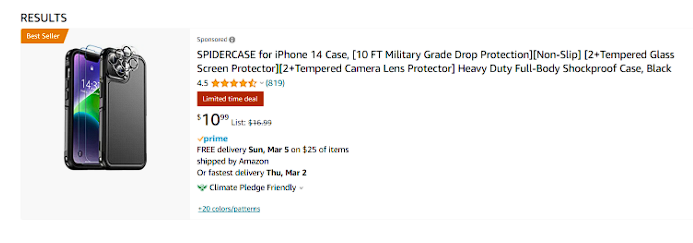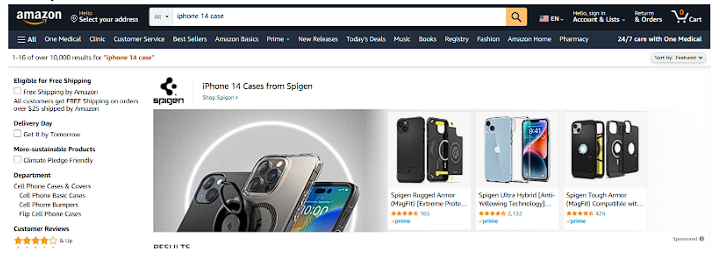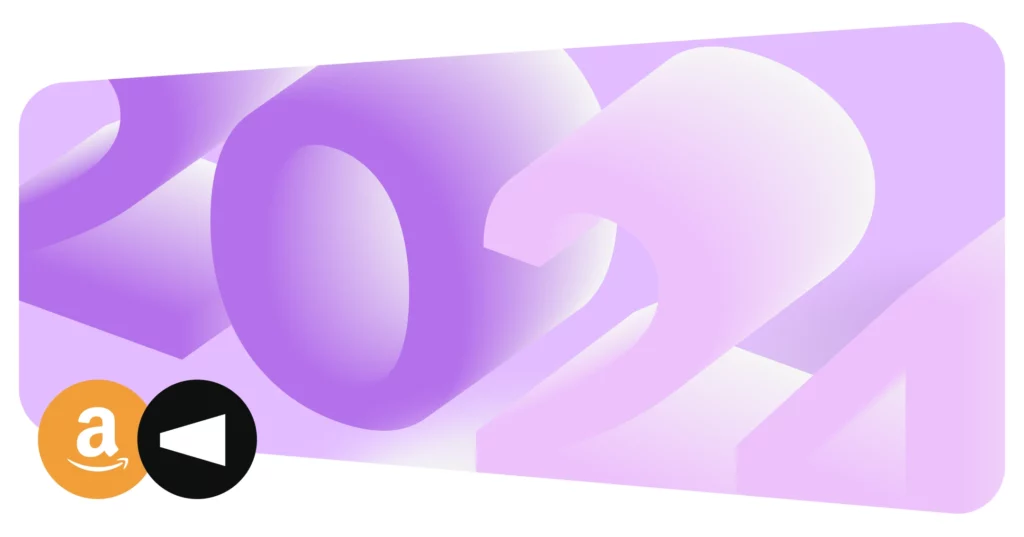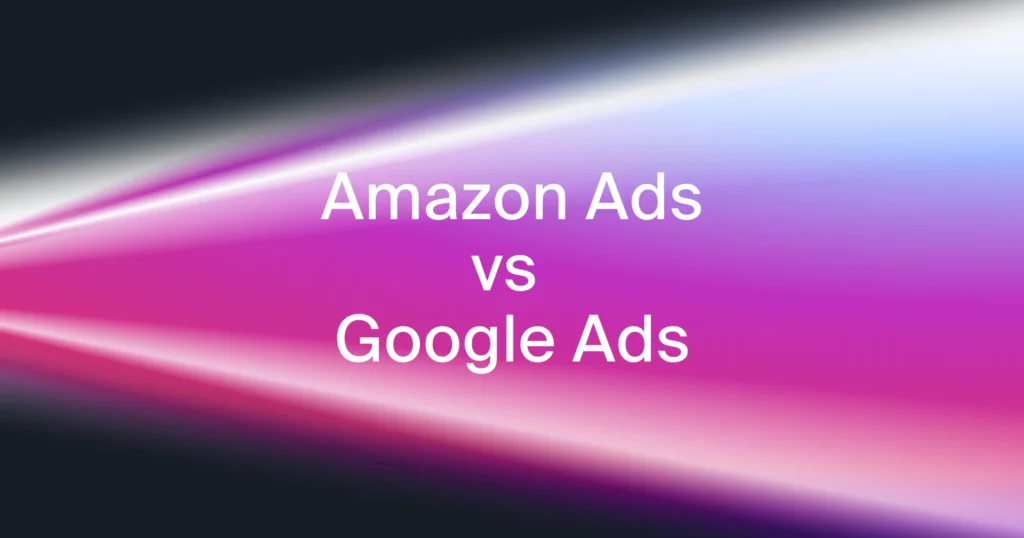
With thousands of sellers and counting on Amazon’s marketplace, it may seem impossible to break through the noise and generate traffic to your product pages. Thankfully, Amazon PPC (pay-per-click) advertising has an average conversion rate of 9.87% and has become a proven strategy for capturing the attention of customers who know what they want and are ready to buy.
It could take a long time to generate sufficient traffic and sales organically, but Amazon PPC lets you skip the line — for a price, of course.
Keep reading if you want to learn how to promote your Amazon products to the right customers. In this article, we go over the different types of Amazon PPC campaigns, how to set up and manage campaigns, and some key terminology you should know. Plus, we share some tips for maximizing your return on investment from Amazon advertising.
Table of Contents
What is Amazon PPC?
Amazon PPC is Amazon’s advertising platform for third-party sellers. Sellers using Amazon PPC can promote their products, store, and brand in various places throughout the marketplace, and they only pay when someone clicks on their ad.
There are several types of Amazon PPC ads including sponsored product, brand, and display ads which we cover later in this post. When creating ad campaigns, sellers bid on keywords and if they win the auction, Amazon will display their ad. Amazon PPC runs on a second-price auction, meaning whoever wins only pays one cent more than the second-highest bid.
What Can Amazon PPC Do for Sellers?
Amazon PPC campaigns are one of the best ways to increase sales and improve your organic ranking over time. They help increase your exposure to customers looking specifically for the type of product you’re selling and who likely have a high intent to purchase.
If you target the right keywords, manage your campaigns effectively, and optimize your product listings, you’ll likely see a good return on your ad spend along with these other benefits:
- Saves you time and effort
- Gives you a better chance of winning the Amazon buy box
- Lowers your ACoS
- Allows you to reach a larger audience
- Increases your organic ranking in search results
- Brings more traffic to your Amazon storefront
Amazon PPC vs Amazon SEO
Amazon PPC is a discipline of Amazon marketing where the seller pays per click to advertise their product on the marketplace.
Amazon SEO is an umbrella term referring to all the effective strategies Amazon sellers and marketers use to increase their product’s organic ranking for specific search terms. By using proven Amazon SEO strategies, your listing will naturally rise in the search results, meaning your product gets clicks for free!
Types of Amazon PPC Ads
Amazon offers a variety of PPC advertising options to meet the needs of different businesses, and it’s important to understand the different types of PPC ads so you can choose the best strategy for your specific advertising goals.
1. Sponsored Product Ads
The most common type of PPC ad, sponsored product ads show up in both search results and product listing pages and are placed to essentially blend in with organic listings.
Amazon creates your ad from the existing product listing and displays your ad in the search results when shoppers search for the keywords you bid on for that product. The minimum daily budget for sponsored product ads is $1, but the more you spend per click, the higher your products could appear on the results page.
By using sponsored product ads, businesses can reach out to their ideal customers precisely when it matters most. Additionally, companies can measure the success of their campaigns and adjust their strategy over time based on their results.
Example:

2. Sponsored Brand Ads
Sponsored brand ads are PPC advertisements that promote your brand or shop, and are reserved for sellers registered with the Amazon Brand Registry.
Sponsored brand ads allow you to promote your brand as a whole and highlight more than one product, making it a popular ad type for established brands on Amazon. They appear on top of, alongside, or within shopping results, and include your brand logo, a custom headline, and three featured products. When customers click on your ad, they’re brought to your product detail pages or Amazon Storefront.
With clickable logos, lifestyle photography, videos, or product categories, sponsored brand ads allow you to show off your brand’s creativity and drive customers to your store. They also give you the ability to track brand discovery with new-to-brand metrics, which measure product orders and sales from first-time customers of your brand.
Targeting the right keywords is essential for both sponsored product and brand ads if you want to reach the right customers. Using an AI tool like Sellesta.ai makes keyword research easy by providing a list of relevant keywords for your listing. You can use these keywords to optimize your product listings and run effective ad campaigns.
Example:

3. Sponsored Display Ads
Sponsored display ads are a unique type of PPC ad that lets sellers retarget customers who have previously visited their product pages on or off the Amazon platform.
This means your ads can appear on Amazon’s marketplace as well as third-party apps and websites, including Google and Facebook. Instead of targeting keywords, Amazon uses rich shopping and contextual signals to help sellers reach the right audiences.
To use this ad type you need to be registered with the Amazon Brand Registry. There is no minimum budget required and you can modify your bid or pause your campaign whenever you like.
Example:

Five Steps for Creating a Great Amazon PPC Campaign
Here are the five essential steps to take when starting your Amazon PPC campaign.
1. Choose Which Products to Promote
To begin, you need to decide which products to promote. Maybe you want to advertise a new product you’re offering or a product that already has a high conversion rate, the choice is up to you. Amazon sales estimators can help you determine which products are most profitable.
Once you pick your product, you need to decide which keywords you want your ad to show up for. Amazon offers manual or automatic keyword targeting. With automatic keyword targeting, Amazon does the work by matching your ads to relevant search terms and products.
If you choose to use manual targeting, doing your own keyword research is the next step. Sellesta.ai provides a keyword research tool specifically for Amazon sellers looking to optimize their ads and product listings for the best search terms.
If you’re new to Amazon PPC, it may be best to start with automated campaigns and then progress to manual campaigns.
2. Optimize Your Product Listings
When it comes to selling products online on any platform, it is essential for businesses to optimize their product listings in order to maximize the likelihood of conversion. Product listings should provide customers with detailed and accurate descriptions and images so they can trust they’re getting a quality product from your brand.
Sellesta.ai is a powerful tool that can help you achieve these goals. It uses a combination of advanced artificial intelligence and predictive analytics to help you create product listings that are optimized for SEO, conversion-focused, and designed to maximize your profits.
If you want to make the most of your Amazon PPC ad campaigns, do not skip this step. Ads bring traffic to your product pages, but whether or not your listing content is optimized can make or break a sale.
3. Create Your PPC Ad Campaign in Seller Central
- Log in to either your Amazon Seller Central or Vendor Central account and go to the Campaign Manager located under the Advertising tab.
- On the Campaign Manager page, set up your budget and choose the duration of your campaign. If you select automatic targeting for an ad, the platform automatically creates a list of keywords. With manual targeting, you get to choose your keywords. Once you have finished, click continue to go to the next step. Then you can create several ad campaigns with various keywords and ASINs and name each ad group.
- Choose the product you want to promote, then decide how much you’re willing to bid for each search keyword. Keep in mind that the number of clicks your ad receives on a daily basis depends on both your default bid amount and your daily budget. If you’re using manual targeting, you will be asked to decide which keywords to bid on for the campaign. Initially, you will have to try different options, but Amazon will offer recommendations.
- Upon clicking save and finish, you will be directed back to the campaign manager page. A confirmation message of “Success!” should appear. Be aware that your ads may need to go through a review process and may take a few hours or days until they’re live.
4. Set Up Bids for Target Keywords
When bidding on keywords, you get to choose a match type. Match types can be incredibly useful in Amazon advertising campaigns, as they let you determine the breadth of search queries you want your ad to be eligible for.
This means you don’t have to worry about potential customers using a phrase you haven’t thought of when searching for a product. Utilizing match types can help you to find potential customers, determine the right keywords to focus on, and prevent you from wasting money on irrelevant queries.
There are three keyword match types: exact match, phrase match, and broad match.
- Exact Match: This type only allows your ad to show when someone searches for the exact keyword in its original order with no other added words. Exact match keywords tend to be the most affordable because you’re only bidding on precise keywords.
- Phrase Match: This can be the exact phrase or a close variation, but the exact keyword needs to be included somewhere in the search term in its original order. Phrase match keywords are a favorite of most advertisers when starting PPC campaigns. That’s because they’re still relatively affordable and enable marketers to attract clicks from customers searching for adjacent keywords.
- Broad Match: These are search terms that contain all of the given keywords in any order, plus others. If you’re a small business with a limited budget, you may want to stay away from broad match keywords because you can easily waste money on keywords that aren’t completely relevant to your product.
Negative Keywords
Using negative keywords in your advertising campaigns gives you more control over the customer search queries that can trigger your ads. This is especially important when adding phrases and broad-match keywords to your campaigns. Negative keywords help prevent your ads from showing up on shopping results pages that don’t align with your campaign objectives.
There are two types of negative keywords: negative exact and negative phrase.
- Negative Exact: Ads that don’t appear with the exact phrase or have a similar variation in search results.
- Negative Phrase: Ads that don’t show up in the search result that have whole phrases or variations.
For instance, if you’re running a phrase match campaign for “camping stoves” you may find that your ads appear for keywords including “camping stoves,” “best camping stoves,” and even “mini camping stoves.” Well, if your product is actually a full-size camping stove, you probably want to make a negative keyword for “mini camping stoves.”
5. Submit Your Amazon PPC Ad Campaign for Review
Once Amazon approves your ads, they will launch, and you can begin tracking their performance. Through Amazon’s ad manager, you can review sales reports to determine which campaign types are working effectively.
Amazon may alert you to potential issues and provide tips for fixing them. At the start of your campaign, it is recommended that you check the performance daily to spot any changes that could improve your marketing strategy, such as modifying your keyword targeting, bidding, or budgeting.
Amazon PPC Key Metrics & Definitions
Here, we define some of the most common Amazon PPC metrics you should know.
Return on Ad Spend (RoAS)
RoAS is the amount of revenue earned for every dollar spent on a campaign and is arguably the most important metric when it comes to Amazon PPC.
Advertising Cost of Sale (ACoS)
ACoS determines the ratio between the amount spent on the campaign and the amount earned from it. This helps to determine if the campaign was conducted cost-effectively or not.
Impressions
Impressions count the number of people who have seen your advertisement.
Clicks
Clicks measure the number of times people click on your advertisement.
Click-Through Rate (CTR)
CTR is the ratio between how many shoppers have clicked on your ad and the number of people who have seen it.
Total Spend
The sum of all expenditures for the complete dataset, without any filters applied.
Overall Sales
Also known as total sales, overall sales is the summary of all cash, credit, installment, and conditional sales made in a given time period.
Cost Per Click (CPC)
An ad’s cost per click (CPC) is a metric that applies to all types of ads, such as those with text, images, or videos. It measures the amount a company pays to receive a single click on the ad.
Conversion Rate
Conversion rate measures the number of page visits that originated from ad clicks that result in a sale.
Amazon PPC FAQs
These are answers to some of the most frequently asked questions about Amazon PPC.
What is the difference between CPC and PPC?
PPC (Pay-Per-Click) and CPC (Cost-Per-Click) are essentially the same things, PPC is the system where brands pay for each click on an ad, and CPC measures how much you pay for each click.
How long does Amazon PPC take to work?
Typically, it may take 3 to 9 months for a PPC campaign to succeed. Use the initial few months to collect data from the ads to further your keyword targeting, audience targeting, and bids. Remember, optimization is an ongoing process.
How much should I budget for Amazon PPC?
To calculate your budget for an Amazon PPC campaign, the first step is to identify your ACoS. This will help you determine how much money you can spend on ads without hurting your profit margins. Afterward, you can calculate your average daily and fixed budgets. For those just starting, it is advisable not to spend more than 25% of your budget on ads.
What are automatic vs manual Amazon campaigns?
Automatic targeting is the most convenient and speedy way to begin running ads because Amazon does the keyword research for you by displaying your ads for relevant search queries.
Manual targeting is the option for more experienced advertisers who want control over when and where their ads will be seen. You can select the keywords and products to target with manual targeting and adjust bids accordingly.
Boost Your Amazon PPC Campaign ROI
For Amazon sellers, a successful PPC campaign can drastically increase your sales and brand awareness. Understanding the different types of PPC campaigns and how to set them up correctly will take time. But, reading this guide is a great first step towards setting up successful Amazon PPC campaigns that are optimized and cost-efficient. And, with help from the right tools, you can start launching profit-boosting campaigns in no time.
Want a jump start? Sellesta.ai is designed to help Amazon sellers maximize the return on their PPC campaigns. Powered by AI, it lets sellers optimize their listings, perform keyword research, and track their performance with review analyses. Sellesta.ai helps Amazon sellers save time and money while maximizing their PPC campaign ROI.


